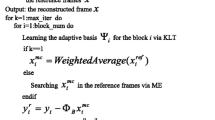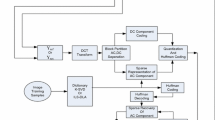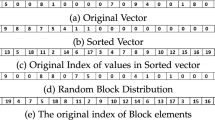Abstract
Sparsifying transform is an important prerequisite in compressed sensing. And it is practically significant to research the fast and efficient signal sparse representation methods. In this paper, we propose an adaptive K-BRP (AK-BRP) dictionary learning algorithm. The bilateral random projection (BRP), a method of low rank approximation, is used to update the dictionary atoms. Furthermore, in the sparse coding stage, an adaptive sparsity constraint is utilized to obtain sparse representation coefficient and helps to improve the efficiency of the dictionary update stage further. Finally, for video frame sparse representation, our adaptive dictionary learning algorithm achieves better performance than K-SVD dictionary learning algorithm in terms of computation cost. And our method produces smaller reconstruction error as well.





Similar content being viewed by others
References
Aharon M, Elad M, Bruckstein A (2006) K-SVD: an algorithm for designing overcomplete dictionaries for sparse representation. IEEE Trans Signal Process 54(11):4311–4322
Anaraki PF, Hughes SM (2013) Compressive K-SVD. In: Proceedings of the 2013 I.E. International Conference on Acoustics, Speech, and Signal Processing. Vancouver, Canada: IEEE, 5469–5473
Bahrampour S, Nasrabadi NM, Ray A, and Jenkins WK (2015) “Multimodal task-driven dictionary learning for image classification,” arXiv: 1502.01094
Candès E, Tao T (2006) Near optional signal recovery from random projections: universal encoding strategies [J]. IEEE Trans Inf Theory 52(12):5406–5425
Candès EJ, Wakin MB (2008) An intoduction to compressive sampling. IEEE Signal Process Mag 25(2):21–30
Tianyi Zhou and Dacheng Tao (2012) Bilateral random projections, Proceedings of the 2012 I.E. International Symposium on Information Theory, pp. 1286–1290
Tianyi Zhou and Dacheng Zhao (2011) GoDec: Randomized low-rank and sparse matrix decomposition in noisy case, Proceedings of the 28th International Conference on Machine Learning, pp. 33–40
Delgado KK, Murray JF, Rao BD (2003) Dictionary learning algorithms for sparse representation. Neural Comput 15:349–396
Donoho DL (2006) Compressed sensing. IEEE Trans Inf Theory 52(4):1289–1306
Donoho DL, Huo XM (2001) Uncertainty principles and ideal atomic decomposition. IEEE Trans Inf Theory 47(7):2845–2862
Donoho DL, Tsaig Y (2006) Extensions of compressed sensing [J]. Signal Process 86(3):533–548
Donoho DL, Tsaig Y (2008) Fast solution of l 1-norm minimization problems when the solution may be sparse. IEEE Trans Inf Theory 54(11):4789–812
Elad M, Aharon M (2006) Image denoising via sparse and redundant representations over learned dictionaries. IEEE Trans Signal Process 15(12):3736–3745
Liu W, Yu Z, Yang M, Lu L, Zou Y (2015) Joint kernel dictionary and classifier learning for sparse coding via locality preserving K-SVD, in: Proceedings of IEEE International Conference on Mutimedia and Expo (ICME), pp.1-6
Liu XM, Zhai DM, Zhao DB, Gao W (2013) Image super-resolution via hierarchical and collaborative sparse representation. In: Proceedings of the 2013 Data Compression Conference. Snowbird, USA: IEEE, 93–102
Mailhe B, Barchiesi D, Plumbley MD (2012) INK-SVD: learning incoherent dictionaries for sparse representation. In: Proceedings of the 2012 International Conference on Acoustics, Speech, and Signal Processing (ICASSP). Kyoto, Japan, USA: IEEE, 3573–3576
Protter M, Elad M (2009) Image sequence denoising via sparse and redundant representations. IEEE Trans Image Process 18(1):27–36
Ravishankar S, Bresler Y (2011) MR image reconstruction from highly undersampled K-space data by dictionary learning. IEEE Trans Med Imaging 30(5):1028–1041
ROWEISS (1998) EM algorithms for PCA and SPCA [C] // Proceedings of the 1997 Conference on Advances in Neural Information Processing System. Cambridge: Press, 626-632
Rubinstein R, Bruckstein A, Elad M (2010) Dictionaries for sparse representation modeling. Proc IEEE 98(6):1045–1057
Rubinstein R, Zibulevsky M, Elad M (2010) Double sparsity: learning sparse dictionaries for sparse signal approximation. IEEE Trans Signal Process 58(3):1553–1564
Zhang Q and Li B (2010) “Discriminative K-SVD for dictionary learning in face recognition,” in Proc. IEEE Conf. CVPR, pp. 2691–2698
Zhang L, Zhang L, Mou X, Zhang D (2012) FSIM: a feature SIMilarity index for image quality assessment. IEEE Trans Image Process 20(8):2378–2386
Zhang J, Zhao C, Zhao D et al (2014) Image compressive sensing recovery using adaptively learned sparsifying basis via l 0 minimization [J]. Signal Process 103(10):114–126
Zheng H, Tao D (2015) Discriminative dictionary learning via fisher discrimination K-SVD algorithm. Neurocomputing 162:9–15
Zhou FF and Li L (2015) A novel K-RBP dictionary learning algorithm for video image sparse representation, Journal of Computational Information Systems, vol. 11 (1), pp.1-11
Acknowledgments
This work was supported in part by National Natural Science Foundation of China (Granted No. 61070234, 61071167, 61373137, 61501251), university graduate student research innovation project of Jiangsu province in 2014 (Granted NO. KYZZ_0233) and in 2015 (Granted NO. KYZZ15_0235) and the NUPTSF (Granted No. NY214191).
Author information
Authors and Affiliations
Corresponding author
Rights and permissions
About this article
Cite this article
Qian, Y., Li, L., Yang, Z. et al. An AK-BRP dictionary learning algorithm for video frame sparse representation in compressed sensing. Multimed Tools Appl 76, 23739–23755 (2017). https://doi.org/10.1007/s11042-016-4134-3
Received:
Revised:
Accepted:
Published:
Issue Date:
DOI: https://doi.org/10.1007/s11042-016-4134-3




